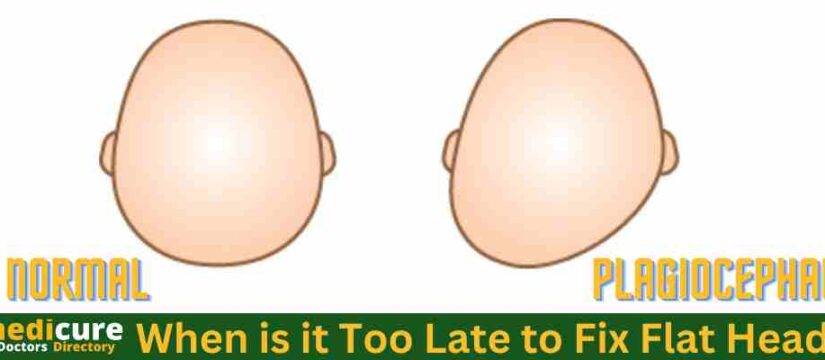MediCure
Understanding Plagiocephaly and Treatment Options
Plagiocephaly, normally known as level head disorder, is a condition that influences numerous babies. It happens when there is a level spot on one side or the rear of a child’s head. The condition can occur due to the baby lying in the same position for prolonged periods. It tends to worry for guardians and parental figures as it can influence the child’s appearance and cause formative issues. In this article, we will examine the reasons for plagiocephaly, when is it too late to fix flat head, and the treatment options available.
When is it Too Late to Fix Flat Head?
Causes of Plagiocephaly
There are a few reasons for plagiocephaly, including:
Positional Plagiocephaly
This is the most well-known kind of plagiocephaly, which happens when the child’s head is similarly situated for expanded periods. This can occur because of the accompanying reasons:
- Sleeping on the back
- Frequent use of car seats or carriers
- Restricted movements due to other medical conditions
- Limited floor time
- Congenital Plagiocephaly
This type of plagiocephaly is present at birth and can occur due to the following reasons:
- Multiple births
- Abnormal head shape
- Fetal constraints
- Intrauterine growth restriction
When is it Too Late to Fix Flat Head?
It is fundamental for look for treatment for plagiocephaly as soon as conceivable to keep away from any drawn out impacts. The American Institute of Pediatrics suggests beginning treatment before a half year old enough. In any case, amending level head condition at whatever stage in life with suitable treatment is conceivable.
Treatment Options
There are different treatment choices accessible for plagiocephaly, contingent upon the seriousness of the condition. Here are some normal treatment choices:
Repositioning
Repositioning is the most effective and least invasive treatment for positional plagiocephaly. It involves changing the baby’s position frequently, using different sleeping positions and encouraging tummy time.
Helmet Therapy
Helmet therapy is a treatment option for severe cases of plagiocephaly. It involves the use of a custom-made helmet that applies pressure to the baby’s head in specific areas to promote growth and shape correction.
Physical Therapy
Physical therapy can help infants with plagiocephaly by improving their neck and head movements. It can include exercises that help strengthen the neck muscles, improve head control, and promote mobility.
Conclusion
Plagiocephaly can be an unsettling condition for guardians and parental figures. It means quite a bit to look for treatment as soon as conceivable to keep away from long haul impacts. Notwithstanding, it is never beyond any good time to treat level head disorder with proper mediations like repositioning, cap treatment, and exercise based recuperation. Address a pediatrician or an expert to decide the best treatment choice for your child.

FAQs of When is it Too Late to Fix Flat Head?
1. Can plagiocephaly cause developmental delays?
Yes, severe cases of plagiocephaly can cause developmental delays. It can affect the baby’s motor skills, vision, and hearing.
2. How long does helmet therapy take?
The duration of helmet therapy depends on the severity of the condition and the baby’s age. It can take anywhere from a few weeks to several months.
3. Can repositioning cure plagiocephaly?
Yes, repositioning can cure positional plagiocephaly in most cases if started early.
4. Is plagiocephaly painful for babies?
Plagiocephaly is not painful for babies, but it can cause discomfort if left untreated.
5. Can adults develop plagiocephaly?
Yes, grown-ups can foster plagiocephaly because of head injury or conditions, for example, craniosynostosis. Be that as it may, it is less considered normal in grown-ups contrasted with babies.
6. What are some ways to prevent plagiocephaly?
Some ways to prevent plagiocephaly include encouraging tummy time, alternating the baby’s sleeping position, and limiting the use of car seats and carriers.
7. Is helmet therapy covered by insurance?
Helmet therapy may be covered by insurance in some cases. It is recommended to speak to your insurance provider and healthcare provider to determine coverage and cost.
8. Can plagiocephaly cause speech delays?
Plagiocephaly has not been straightforwardly connected to discourse delays. In any case, whenever left untreated and serious, it can create formative setbacks that might influence discourse and language improvement.
9. Is medical procedure a possibility for plagiocephaly?
Medical procedure is just suggested in serious instances of plagiocephaly, typically due to craniosynostosis. It is ordinarily a final retreat choice and requires an interview with a trained professional.
10. How long does it take for active recuperation to show results?
The length of exercise based recuperation and the time it takes to get results relies upon the seriousness of the condition and the child’s age. It can take anyplace from half a month to a while to see improvement.
Also Read:
